 The guys at Hop Talk laid down this challenge for today’s version of The Session:
The guys at Hop Talk laid down this challenge for today’s version of The Session:
So, we want to know about the “Atmosphere” in which you enjoy beer. Where is your favorite place to have a beer? When? With whom? Most importantly:
Why?
Taking a quick look at the ongoing roundup I see bloggers are passionate about this topic. Do you think we’d similar posts were the topic for Wine Blogging Wednesday?
And given a month to consider the subject I’m still scratching my chin. I know the “with whom?” (My wife, Daria.) But one favorite?
In the 11-plus years since the first Beer Travelers Guide was published we’ve been asked hundreds of times “What’s your favorite place?” Never have had an answer and still don’t.
So here’s one we’d talk about when people would say they were looking for “something like Cheers.” The disclaimer is that we last visited the Northeast Taproom in Reading, Pa., 10 years ago. Pete Cammarano since sold the place. This isn’t about now; it was written in January of 1997. I think it’s about the sort of place a lot of people are looking for – having little to do with the “quality” of the beer – and that these “third places” (another discussion) are disappearing.
January 1997: Pete is the answer
Everybody may not know your name at the Northeast Taproom in Reading, Pa., but they will all know the name owner-bartender Pete Cammarano gives you. For instance, Marty Acaster remembers walking through the front door and being greeted by Pete:
“It’s a miracle,” Pete would say, because he had given Acaster the name “Miracle Marty,” after the local Miracle Mart. “My favorite thing is that over the years, some people don’t even know other people’s names,” Pete said. “Just what we call them here.”
 And these are people who see each other all the time. Pete estimates that nearly 50 percent of his customers visit once a week. Talk about regulars. And if you call those who visit every three weeks regulars, then “it’s amazing.” There’s a regular Thursday night crowd, a regular Wednesday night crowd … . On most days, Dave — who usually orders Whitbread or North Coast Red Seal — is the first customer.
And these are people who see each other all the time. Pete estimates that nearly 50 percent of his customers visit once a week. Talk about regulars. And if you call those who visit every three weeks regulars, then “it’s amazing.” There’s a regular Thursday night crowd, a regular Wednesday night crowd … . On most days, Dave — who usually orders Whitbread or North Coast Red Seal — is the first customer.
Certainly there are beer tourists. The beer selection doesn’t get much better than here.
Pete, who’ll be 40 this year and has been basically the only guy behind the bar since he bought the place in 1983, is a beer pioneer. “How’s the board look?” he’ll ask when you walk in, inviting you to make a tough but wonderful choice right off.
When he bought the place, the draught choices were Budweiser and Schmidt’s. “I didn’t have any customers. I was playing Store,” he said. There were still more than 100 taprooms in Reading then, most of them neighborhood hangouts. Pete bought the place from a woman who ran it with her 92-year-old mother, opening it a few hours a day to serve five or six customers, then closing before 5 p.m. each day.
The first thing Pete did was replace Budweiser with Yuengling Porter so he could serve black-and-tans. Each week, he’d buy another case of exotic beer. “I remember the first time I bought Sam Smith’s (from England), I just sat there staring at the case. It seemed like such a big outlay.”
Sometimes he drove to nearby towns to get beer. “I was kind of a freak,” he said. “There wasn’t a salesman in town who thought I was sane.”
The number of taverns in Reading has shrunk dramatically in the last 10 years, so maybe the beer selection had something to do with the Taproom’s success. “I imagine so,” Pete said. It’s a formula others would like to follow, but while a delightful number of bars in Pennsylvania have begun to make “good beer” their theme, you can’t manufacture the 14 years of history built in here.
Is it more the beer or more the place itself? Pete shrugs at the question. “Somehow I managed to get the friendliest people in town,” he said.
When we visited last month we found not much had changed since we walked in the first time and said, “Wow.” Pete has added a handpump for keg-conditioned beers and is talking about changing the pizza recipe. But what we wrote a year and a half ago for the Beer Travelers Guide pretty well explains why we’re as happy to drink beer here as we are anyplace else in the country:
Referring to the Northeast Taproom in Bars of Reading & Berks, published in 1988, authors Suds Kroge and Dregs Donnigan wrote, “Parking is a bitch, the service sucks and the men’s room stinks—we love this place. Pete is the answer … but we forget the question.”
Things haven’t changed much since then. Parking can be challenging on the hilly and narrow streets nearby, and the men’s room is a tiny closet (the sink hangs on the wall outside, in the bar area). But the service was fine, and Pete was still behind the bar, dispensing beer and beer advice.
It was the best bar in Berks County for serious beer drinkers back in 1988, and it’s still the best. The 13 draught choices include a well-chosen mixture of imports and American craft beers, both regional (Stoudt’s) and from afar (Hoegaarden White). While it seems just about anybody can cram a cooler with 100 bottles these days, this is always a cooler worth visiting. The tap choices are listed on a blackboard decorated with a large, carved bartender.
The Taproom is a place out of pop culture, sometimes politically incorrect. Next to a framed set of antique dog-trial ribbons is a picture of a woman with her fist stuck in her mouth. There are old signs, pieces of local artwork, beer advertisements, kids’ drawings and autographed pictures scattered about the bar area and on into an upstairs room. Autographed photos include those from Connie Chung, Joe Paterno, Frank Sinatra and a personalized picture from Captain Kangaroo. Stuffed animals are tucked here and there: a small bear on the beer cooler, an unusually gross boar’s head, a mangy owl, and a porcupine tied to a scratching post beside a window.
As evening set in, the only light in the taproom came from stuff that was lighted—the Anchor neon in the window, a clock, the cooler, the Beer on Tap sign, the jukebox . … A basset hound wandered in, and the patrons started talking about beer. “This beer tastes like beef jerky,” a woman said. New beers out of Philly were critiqued, then the decision of businesses such as Boston Beer Co. and Pete’s Brewing Co. to “go public.”
Soon the basset hound was curled up on the footrest under the bar, and somebody had punched up a track by the group Rusted Root on the jukebox.
Did we mention the Lava Lamp?
The bad news is that on this trip we found out that some college students stole the porcupine. We also learned more that makes the place endearing. The basset is Pete’s dog, Tapper, and he’s been going to work with the boss for 12 years. For the last three years, Pete has given regulars Taproom nightlights, and they are so popular he also sells them.
Then there’s the Spam Carvin’ competition, held for six years now. Pete buys the Spam, and contestants then pay $5 a can, with the money going to the Berks County Food Bank. Four hundred dollars was raised last year.
The winning entry last year was “Spamel Joe,” an interpretation of Joe Camel, with “Spamtasia” second. Regulars say Pete kept the winner right there on the bar for going on a month before it had to be thrown out.
By then, it probably knew everybody’s name.
 The guys at Hop Talk laid down this challenge for today’s version of The Session:
The guys at Hop Talk laid down this challenge for today’s version of The Session: And these are people who see each other all the time. Pete estimates that nearly 50 percent of his customers visit once a week. Talk about regulars. And if you call those who visit every three weeks regulars, then “it’s amazing.” There’s a regular Thursday night crowd, a regular Wednesday night crowd … . On most days, Dave — who usually orders Whitbread or North Coast Red Seal — is the first customer.
And these are people who see each other all the time. Pete estimates that nearly 50 percent of his customers visit once a week. Talk about regulars. And if you call those who visit every three weeks regulars, then “it’s amazing.” There’s a regular Thursday night crowd, a regular Wednesday night crowd … . On most days, Dave — who usually orders Whitbread or North Coast Red Seal — is the first customer.